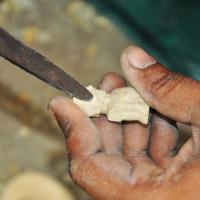Design Gallery
Making of Wooden Toys - Kondapalli
Toy Making Process
by
Mr. Antony William, Ms. Shruti K., Ms. Pargnya and Mr. Mahendra Patidar
Kondapalli toys have been famous for quite a number of decades. The wood used for carving Kondapalli wooden toys is from the tree called “Tella Poniki’ (White Sander wood and botanically called Jiuotia Rotteri Fromis) and this grows abundantly in local forest. Tella poniki wood is very soft and light in nature; hence it is chosen to make wooden toys. Before cutting, the wood is treated by warming as the weight of the wood reduces to one third of the original weight. After treating, Tella Poniki timber is cut into required blocks. Initially, the design is marked on the surface of the wood. The wood blocks are then carved with bahudara (chisel) into the desired shape of the toy. The chiseled components are then filed to remove uneven edges. All the pieces like Body, Head, Ears, Trunk, Tail are carved separately and fitted together with glue and a slow process of heating on a wire frame is done to evaporate the moisture. Once the carving is done, the early-prepared Aakra paste is applied to the toy to fill the crcks and also to give proper shape of the toy. The toy is dried and then smoothened by rubbing with sand paper. Once the surface is smoothened, it is sent for coloring process. Primarily, the karigars (artisans) used Vegetable dyes for coloring and then migrated to synthetic paints and now they make in both the flavors. Vegetable dye based artifacts are bit costlier than the painted ones. Now-A-Days artisan’s uses enamel colors, as they are economical and easily available in market. Before painting, wood primer solution is coated on the wood to avoid color absorption and also to enhance the life of enamel colors. Artisan spontaneously creates designs of their own imagination on the toy. Different contrast colors are used to highlight the outer look and appeal. Most popularly used colors are bright red, green, yellow, black, white and blue.
For more details:
https://www.dsource.in/resource/wooden-toys-kondapalli























